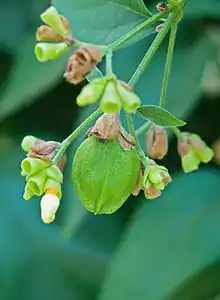Nyctanthes arbor-tristis
Nyctanthes arbor-tristis, the night-flowering jasmine or Parijat or hengra bubar or Shiuli is a species of Nyctanthes native to South Asia and Southeast Asia.[1][2][3][4]
| Parijat, Hengra bubar, night-flowering jasmine, Shiuli | |
|---|---|
 | |
| Scientific classification | |
| Kingdom: | Plantae |
| Clade: | Tracheophytes |
| Clade: | Angiosperms |
| Clade: | Eudicots |
| Clade: | Asterids |
| Order: | Lamiales |
| Family: | Oleaceae |
| Genus: | Nyctanthes |
| Species: | N. arbor-tristis |
| Binomial name | |
| Nyctanthes arbor-tristis | |
| Synonyms[1] | |
Nyctanthes arbor-tristis is a shrub or a small tree growing to 10 m (33 ft) tall, with flaky grey bark. The leaves are opposite, simple, 6–12 cm (2.4–4.7 in) long and 2–6.5 cm (0.79–2.56 in) broad, with an entire margin. The flowers are fragrant, with a five- to eight-lobed white corolla with an orange-red centre; they are produced in clusters of two to seven together, with individual flowers opening at dusk and finishing at dawn. The fruit is a bilobed, flat brown heart-shaped to round capsule 2 cm (0.79 in) diameter, each lobe containing a single seed.[3][4]
Names and symbolism


The tree is sometimes called the "tree of sorrow", because the flowers lose their brightness during daytime; the scientific name arbor-tristis also means "sad tree". The flowers can be used as a source of yellow dye for clothing. The flower is called Gangaseuli and some where Jharaa sephali in Odisha, India. In the Borok Tipruri culture of Tripura, it is associated with the cycle of life i.e. birth and dying. It is popularly used as a garland for the dead.
The flower is the official flower of the state of West Bengal, and is also known as Parijat, Shefali and Siuli in local West Bengal region in India, and for Kanchanaburi Province, Thailand.[5] Nyctanthes arbor-tristis is commonly known as night-flowering jasmine and coral jasmine. It is referred to as Har-shringaar in Bihar's Mithilanchal and Madhesh. It is called Xewālee (hewālee, শেৱালী) in Assamese, while in Sri Lanka, it is called Sepalika (සේපාලිකා). In Kerala, where it is called Pavizhamalli (പവിഴമല്ലി) in Malayalam, Pavazhamalli (பவழ மல்லி) in Tamil,paardak(पार्दक) in Konkani. In Myanmar, it is called Seikphalu ( my:ဆိပ်ဖလူး ). It is used for Pujas and such ceremonies . It also has importance in old Malayalam romantic songs.
Significance in Hinduism
Parijat appears in several Hindu religious stories and is often related to the Kalpavriksha. In one story, which appears in Bhagavata Purana, the Mahabharata and the Vishnu Purana, parijat appeared as the result of the Samudra manthan (Churning of the Milky Ocean) and Lord Krishna battled with Indra to win parijat. Further on, his wife Satyabhama demanded the tree be planted in the backyard of her palace. It so happened that in spite of having the tree in her backyard, the flowers used to fall in the adjacent backyard of the other queen Rukmini, who was favourite of Lord Krishna, because of her superior devotion and humility. It is the subject of a prabandha named Parijatapaharanamu in Telugu literature written by Nandi Thimmana, the court-poet of Krishnadevaraya. India's Prime Minister Narendra Modi on August 5, 2020[6] participated in a "Bhoomi Pujan" or a groundbreaking ceremony that marks the building of the Ram temple in Ayodhya. Before laying the foundation stone of the temple, PM Modi planted a Parijat sapling in the temple premises.
Uses
Traditional Medicine
The leaves have been used in Ayurvedic medicine and Homoeopathy for sciatica, arthritis, and fevers, and as a laxative.[7]
Chemical constituents
%252C_Kolkata%252C_India_-_20070130.jpg.webp)
- Leaves: The leaves contain D-mannitol, β-sitosterol, flavanol glycosides, astragalin, nicotiflorin, oleanolic acid, nyctanthic acid, tannic acid, ascorbic acid, methyl salicylate, an amorphous glycoside, an amorphous resin, trace of volatile oil, carotene, friedeline, lupeol, mannitol, glucose, fructose, iridoid glycosides, and benzoic acid.
- Flowers: The flowers contain essential oils, nyctanthin, D-mannitol, tannins, glucose, carotenoids, glycosides including β-monogentiobioside ester of α-crocetin (or crocin-3), β-monogentiobioside-β-D monoglucoside ester of α-crocetin, and β-digentiobioside ester of α-crocetin (or crocin-1).
- Seeds: The seeds contain arbortristosides A and B; glycerides of linoleic, oleic, lignoceric, stearic, palmitic and myristic acids; nyctanthic acid; 3,4-secotriterpene acid; and a water-soluble polysaccharide composed of D-glucose and D-mannose.
- Bark: The bark contains glycosides and alkaloids.
- Stem: The stems contain the glycoside naringenin-4’-0-β-glucapyranosyl-α-xylopyranoside and β-sitosterol.
- Flower oil: The flower oil contains α-pinene, p-cymene, 1-hexanol, methylheptanone, phenyl acetaldehyde, 1-decenol and anisaldehyde.
- Plant: The plant contains 2,3,4,6-tetra-0-methyl-D-glucose; 2,3,6 tri-0-methyl-D-glucose; 2,3,6-tri-0-methyl-D-mannose; 2,3,-di-0-methyl-D-mannose; arbortristosides A, B, and C; and iridoid glycosides.
References
- Kew World Checklist of Selected Plant Families, Nyctanthes arbor-tristis
- "Nyctanthes arbor-tristis". Germplasm Resources Information Network (GRIN). Agricultural Research Service (ARS), United States Department of Agriculture (USDA). Retrieved 16 December 2017.
- Flora of Pakistan: Nyctanthes arbor-tristis
- AgroForestry Tree Database: Nyctanthes arbor-tristis Archived 2011-07-16 at the Wayback Machine
- Nyctanthes arbor-tristisArchived 2 July 2017 at the Wayback Machine
- "Watch: PM Narendra Modi Plants Parijat Sapling At Ram Temple". NDTV.com. Retrieved 2020-10-10.
- Saxena RS, Gupta B, Lata S (August 2002). "Tranquilizing, antihistaminic and purgative activity of Nyctanthes arbor tristis leaf extract". J Ethnopharmacol. 81 (3): 321–5. doi:10.1016/S0378-8741(02)00088-0. PMID 12127232.
_LACMA_M.72.1.26.jpg.webp)